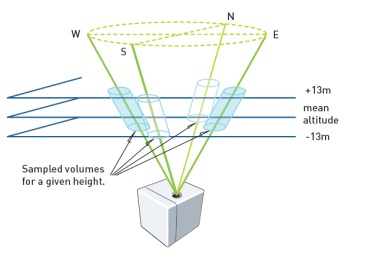DWL Fundamentals
The LIDAR is an active remote sensor using a laser as an emitter. The LIDAR emits short pulses of light into the atmosphere. The emitted radiation encounters diffusion by atmospheric particles and molecules along the line of sight. A part of the radiation is scattered backward and collected by an opto-electronic device into the LIDAR reception system. The optical signal is then translated into a voltage over time and distance by multiplication of the speed of light. An accurate range dependent profile of backscattered light is obtained by calibrating the optical signal.
Added to this backscattering information, a coherent LIDAR technology has been designed to provide the most accurate and fastest technology for windspeed monitoring in the atmosphere. This LIDAR enables users to measure the wind speed and direction, using the Doppler effect on small particles, as a radar could follow large droplets or planes, depending on its frequency. Hence using several line of sights at different angles, windspeed and direction are
retrieved by projection very accurately.

